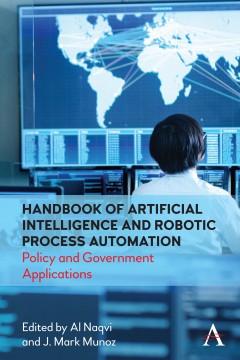Handbook of Artificial Intelligence and Robotic Process Automation
Policy and Government Applications
Edited by Al Naqvi & J. Mark Munoz
Other Formats Available:
E-Book- About This Book
- Reviews
- Author Information
- Series
- Table of Contents
- Links
- Podcasts
About This Book
On the commercial side, artificial intelligence applications are powering many sectors. Globally, governments are exploring how to comprehend, incorporate, apply, and use artificial intelligence technologies. The scope of government use of artificial intelligence technology goes beyond that of commercial organizations and is far more complex. In government, the challenges will be as follows: (1) How can governments use artificial intelligence technology to improve their efficiencies? (2) How can governments become more citizen-centric, service based, accessible, and responsive? (3) How can governments protect their citizens from the misuse of artificial intelligence (e.g., alleged Russian bots’ interference in U.S. elections)? (4) How can governments use artificial intelligence technology to make better policy decisions and avoid wrong decisions (economic, social etc.)? (5) How can governments develop new standards to govern and manage the deployment of artificial intelligence technologies (e.g., autonomous cars, financial markets and trading, healthcare bots)? (6) How will the legislative bodies respond to the rise of intelligent machines? (7) How will the use of artificial intelligence in the military change the arms race? (8) What roles governments will need to play in developing global standards related to artificial intelligence (United Nations)? (9) How can governments improve their countries’ productivity with artificial intelligence? (10) How can governments handle the upcoming unemployment that would result from AI automation? All the above questions are at an early stage of exploration and many have not been addressed comprehensively. This book deals with all the above issues and provides the first guide to governments and policy makers of the world on artificial intelligence.
Reviews
“A timely book on a critical issue. The future of any government should include its ability to adopt and embrace the AI revolution. This book supports this vision.” —Tanice (TK) Gonsalves, President of WTI, Washington DC
“The government now recognizes that intelligent automation (AI and RPA) are the key strategies for national security and development. The question remains “how to do it” effectively. This book takes a strategic perspective and focuses on a national strategy for AI.” —Michael McGeehan, Blue Prism, Executive Director of Strategy and Business Development – Public Sector, Washington, DC
Author Information
Professor Al (Ali) Naqvi, one of the pioneers in the field of enterprise artificial intelligence, developed the first and most comprehensive body of knowledge and courses for leading universities in the following areas: AI in corporate strategy, finance, marketing, HR, competitive intelligence, CSR, deep learning, and supply chain management. Al Naqvi, a leading expert in transforming companies from the “e” to the “AI” era, has helped over 300 companies to benefit from his research. His professional research interests include artificial intelligence, applied AI, robotic process automation, deep learning, complex adaptive systems, cognitive organizations and leadership, and strategic cognitive transformation. He teaches several classes on applied artificial intelligence, deep learning, RPA, and cognitive transformation at the American Institute of Artificial Intelligence, Washington DC. He is the editor of the Journal of Artificial Intelligence in Business, Policy, and Economy and has designed several products using deep neural networks.
J. Mark Munoz is a professor of international business at Millikin University in Illinois, and a former visiting fellow at the Kennedy School of Government, Harvard University. He is a recipient of several awards including four best research paper awards, an international book award, a literary award, and the ACBSP Teaching Excellence Award among others. Aside from top-tier journal publications, he has authored/edited/co-edited over twenty books such as Winning Across Borders, International Social Entrepreneurship, Contemporary Microenterprises: Concepts and Cases, Handbook on the Geopolitics of Business, Managerial Forensics, Advances in Geoeconomics, and Global Business Intelligence.
Series
Table of Contents
List of Illustrations; Chapter 1, Introduction, J. Mark Munoz and Al Naqvi; Part I, Strategic Frameworks of AI; Chapter 2, How to develop a country strategy for AI, Al Naqvi; Chapter 3, Global governance of artificial intelligence, Nicolas Miailhe and Yolanda Lannquist; Chapter 4, Government 4.0 and evidence-based policies : AI and data analytics to the rescue, Nathalie de Marcellis-Warin and Thierry Warin; Chapter 5, The strategic implications of artificial intelligence for international security, Jean-Marc Rickli; Part II, AI and Economic Development, Chapter 6, Using AI to improve economic productivity : A business model perspective, Oleksiy Osiyevskyy, Yongjian Bao and Carlos M. DaSilva; Chapter 7, Handling resultant unemployment from artificial intelligence, Margaret Goralski and Krystyna Gorniak-Kocikowska; Chapter 8, Building tech zones to enhance AI, Melodena Stephens; Part III, AI and the Enhancement of Governance; Chapter 9, Ai-government vs. e-government: How to reinvent government with AI?, Al Naqvi; Chapter 10, Economic governance when humans and Ai are at work; Dirk Nicolas Wagner; Chapter 11, Legal systems at a crossroads: Justice in the age of artificial intelligence, Nicolas Economou and Bruce Hedin; Chapter 12, The curious case of fake news: Fighting smart Machiavellian machines, Daniel Lemus Delgado and Armando Lopez-Cuevas; Chapter 13, Applications of artificial intelligence and RPA to improve government performance, Luis Soto and Sergio Biggemann; Chapter 14, Conclusion, J. Mark Munoz and Al Naqvi; Notes on Contributors; Index.
Links
Stay Updated
Information
Latest Tweets



